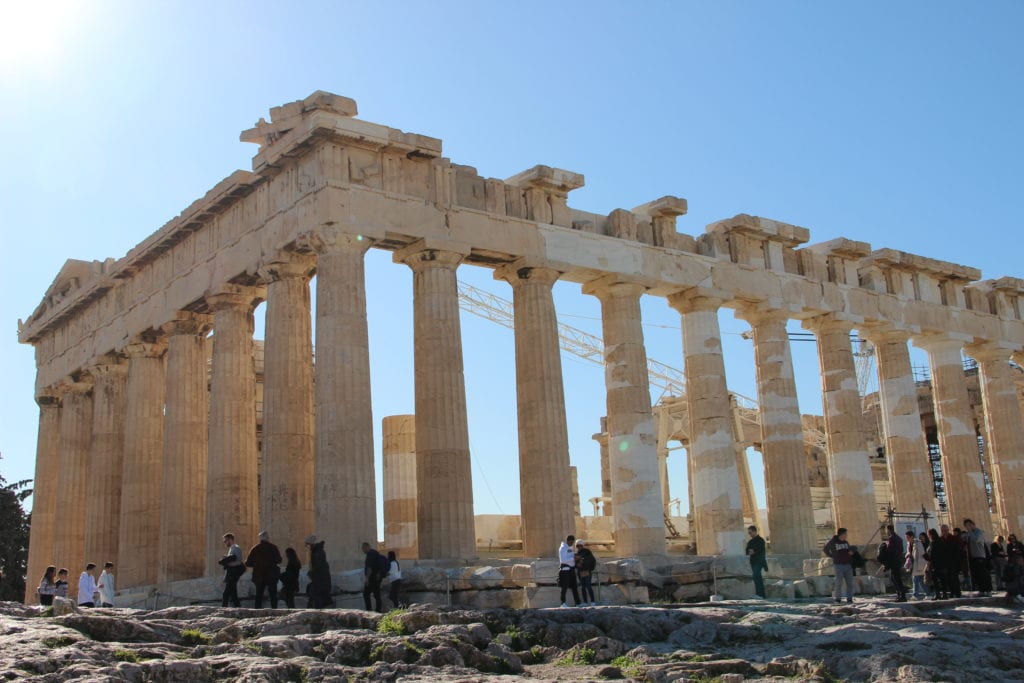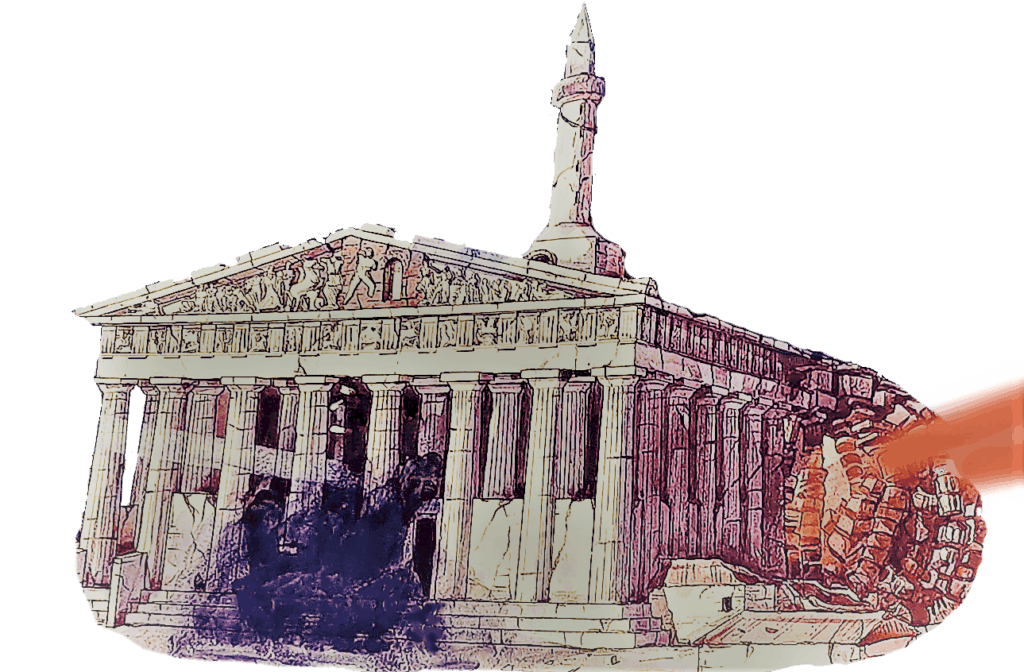Who destroyed the Parthenon? Who sadly bombed it?
When you visit the Parthenon for the first time you may feel disappointed because it doesn’t be well preserved. This is especially true if you don’t know all the things that has happend to the Parthenon.
The primary cause of the Parthenon’s current state was the Venetian-Ottoman war of 1687, where a misplaced cannonball ignited a gunpowder magazine inside the temple. This guide explores the multiple events that ruined the structure, from ancient fires to the controversial removal of sculptures, finally revealing the sad fate of one of the world’s most beautiful temples.
The temple has endured many vicissitudes. Not only has time ruined the Parthenon, but also some people, in the course of history, did their part in taking works of art from the Parthenon. Furthermore, it was also bombed! Who destroyed the Parthenon? Who bombed it?
Table of Contents
Who destroyed the Parthenon?

The First destruction: the fire
The first major destruction occured in 267 AD due to arson. In the late 3rd or late 4th cent A.D., the interior of the temple was destroyed by fire either by Germanic tribe of the Heruli (267 A.D.) or by Alaric’s Visigoths (396 A.D.)
The early Christian period
During the early Christian period (6th cent A.D.), the new perceptions on art led the destruction of many works of art around Greece. This included many of Parthenon’s sculptures.
The Parthenon became the church of the Holy Virgin of Athens, the largest in the city. During the construction of the Christian apse at the east porch, the central scene of the east pediment with the birth of Athena was lost. After 1205, it felt into hands of the Franks of the 4th Crusade, becoming a church of the Latin faith.
If you are interested in the early history of Christianity in Athens, you should also read about the famous talk given by Ap. Paul at the nearby Areopagus (Apostle Paul’s Hill).
The Parthenon becomes a Minaret
When Athens was surrendered to the Ottoman Turks in 1458, the temple became a mosque with a minaret.
In 1687, during the siege of the Acropolis by the troops of Venetian general Francesco Morosini a cannoball made a direct hit in the interior of the temple, which the Turks used as powder magazine. The terrible explosion blew up the roof and destroyed the long sides of the temple as well as parts of its sculptures.
1456 The Ottomans conquer Athens. The site of the Acropolis is used for habitation while the Parthenon is converted in a mosque.
Who bombed it?
Who destroyed the Parthenon? In 1687, during the siege of the Acropolis by the troops of Venetian general Francesco Morosini a cannoball made a direct hit in the interior of the temple, which the Turks used as powder magazine. The terrible explosion blew up the roof ond destroyed the long sides of the temple as well as parts of its sculptures.
1687 The Venetians siege the Acropolis which is under Turkish occupation. An artillery shell hits the Parthenon, which is being used by the Turks as a powder magazine and ignites a colossal explosion. The monument shakes and is widely damaged. The east frieze collapses.
1688 Francesco Morosini, the commanding Admiral of the Venetians, tries to remove the horses and Poseidon statues from the west pediment to transport them to Venice. The operation is unsuccessful, the statues fall dawn to the ground and shatter.

The Parthenon’s Turbulent History: A Timeline of Destruction
Who destroyed the Parthenon? The most severe damage to the monument was caused in 1801-1802, when the Scotch ambassador of England to Constantinople Thomas Bruce, 7th Earl of Elgin, removed the gretest part of the sculptures that also compromised structural members of the temple.
By bribing the Turkish garrison of the Acropolis and employng teams of the Italian artist G.B. Lusieri, Elgin removed and transported to England 19 pedimental sculptures, 15 metopes and the reliefs of 56 sawn blocks of the frieze, today exhibited in the British Museum in London.
1799 Thomas Bruce, 7th Lord of Elgin, is appointed Ambassador of His Brittanic Majesty in Constantinople in order to reinforce the relationships between the Ottoman Empire and Britain.
1800 Elgin organize a mission to Athens in order to, as it was officially stated, study, sketch and make casts of the sculptures of the Parthenon. The group includes architects, moulders and the painter Feodor Ivanovitch. The court’s painter Don Giovanni Battista Luisieri is chosen to led the mission.
Elgin’s fervent desire to obtain the original scupltures emerges very soon and results in the uncontrollable plundering of the Acropolis. Using his political influence and by generously bribing the officils he secures the authorities concession. The removal and transportation of the inscriptions, sculptures and architectural members from the Acropolis begins in July of 1801 and last 4 years.
1802 September. Block V of the eastern frieze, which lays on the ground is sawed off to diminish weight from approximately becomes less than during the transportation it breakes in two pieces.
1802 September 16th The block is packed and loaded on the brig Mentor. During the voyage the ship is hit by a storm and sinks.
1804 – 1805 The cargo’s retrieval is completed. The artifacts from the shipwreck are loaded onboard ship and continue their jouney to England. Block V arrived in London throught Malta.
1801, July 31st. Elgin begins to detach the metopes of the southern side of the Pathenon. Metope 27 is the first one to be removed. The procedure is depicted ans documented by the English painter E. Dodwell, an Eye witness.
“I saw several metopae at the south-east extremity of the temple taken down. They were fixed in between the triglyphs as in a groove; and in order to lift the up it was necessary to throw to the ground the magnificent cornice by which they were covered.”
After its removal from the Parthenon the metope ends up in England in 1802.
1962 The British Museum opens a new room the Duveen Gallery, which houses the sculptures from the Parthenon.
Frequently Asked Questions (FAQ)
Who is primarily responsible for the destruction of the Parthenon?
The primary and most devastating cause of the Parthenon’s current state was the Venetian siege in 1687. A Venetian cannonball ignited a Turkish gunpowder magazine stored inside the structure, causing a massive explosion that blew the roof off and heavily damaged the side walls.
Was the Parthenon destroyed by ancient Greeks or Romans?
No, the Parthenon survived the classical and Roman periods largely intact. The first major damage was caused by a fire in 267 AD, potentially set by the Germanic Heruli tribe, which destroyed the interior roof structure.
Why did the Ottomans use the Parthenon to store gunpowder?
When the Ottomans conquered Athens in the 15th century, the Parthenon was converted into a mosque. Its sturdy central structure made it an ideal, if vulnerable, place to store military supplies, including gunpowder, which was tragically exposed during the 1687 siege.
When did the Parthenon become a Christian church?
The Parthenon was converted into a Christian church, dedicated to the Holy Virgin, during the early Christian period in the 6th century A.D. This conversion involved structural changes, including the demolition of the inner columns.
Who removed the Parthenon sculptures (Elgin Marbles)?
The controversial removal of the remaining sculptures from the Parthenon occurred in the early 19th century by Thomas Bruce, the 7th Earl of Elgin, who transported them to Britain. They are now displayed in the British Museum in London.
YouTube Channel
Have you already Subscribed to our YouTube Channel? Subscribe here!
Related Posts
Who destroyed the Parthenon? Related content: